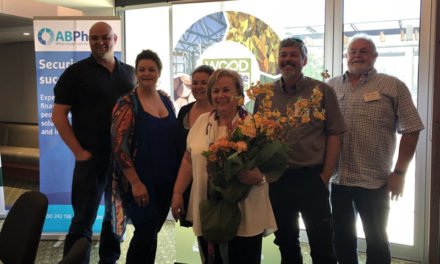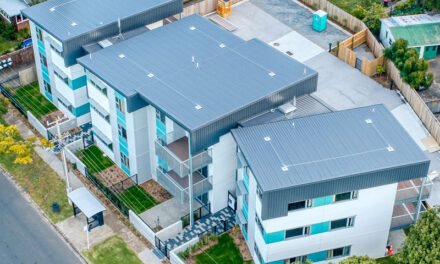We talked with three industry powerhouse firms that are closing the loop on their wood waste and working to make timber a fully circular commodity. By Donyale Harrison
There’s an enormous irony to timber. On the one hand, the sector represents far and away the most sustainable and environmentally responsible building product. On the other hand, a large portion of the wood fibre we harvest ends up as waste, providing a handy stick for those opposed to timber (whether misinformed Greens or steel and concrete manufacturers) to beat us with in the court of public opinion.
Optimising use of the fibre supply from our harvest is a wider problem, but there are major players who have committed to getting the most from their personal fibre streams and in the process bringing the idea of the ‘circular economy’ – one in which products at end of their first life are seen as resource rather than waste and re-purposed for second, third and more lives – into reality.
We spoke with two related firms – reDirect and Australian Panels – about their recycling program, with Dulux about its offcut scheme and with Kennedy’s Timbers about its path to both zero waste and negative carbon costs.
REDIRECTING RE-USE
Three years ago, TTN reported on a new scheme from Borg Manufacturing. The company is famous for its panel and board products and sells directly to fabricators and retailers. As national sales manager Stuart Toakley said of his customers at the time, “we realised they were producing a lot of waste wood, and we need to use a lot of wood fibre.” A trial program was born, bringing that waste back in the empty trucks every time Borg made a delivery.
Fast-forward to now, and that trial has boomed. Aaron Hudson, CEO of reDirect Recycling (which manages the program), says, “In those days we were doing maybe 30 tonnes a day of material – around 7500 tonnes a year. Now we’re at 80,000 tonnes per annum and my goal is for 200,000 to 220,000 tonnes.”
The waste comes through three main streams. The first is customers of the Borg family of companies, particularly the Polytec board and laminate division. “We can re-use all their particle board and softwood offcuts,” says Hudson. “We don’t collect MDF or hardwoods, because they don’t fit our board manufacturing process.”
Front-lift trucks go out to Polytec customers and pick up their particle board and pine offcuts. There’s a cost, but it’s attractive and with added benefits for both parties.
“We charge $100 per bin,” Hudson says. “Your traditional waste companies are charging about $180 a bin. So we’re roughly half price. For those businesses, that cost is obviously an incentive but also that material doesn’t go to a resource recovery centre, it goes into new panels, so they can point to a transparent re-use process. For us, we know that waste has no contaminants or other unwanted materials. It can go directly to one of our four facilities to be shredded.”
Once shredded to the right size for the next stage in the manufacturing process, the waste is put into a walking floor – a huge truck that can hold 20-22 tonnes of shredded timber, and then shipped to the manufacturing site at Oberon where it’s made into new panels.
“We call it cradle to cradle,” says Hudson. “It’s not just one re-use, it’s designed to be endlessly reusable. We can recollect it and re-manufacture it into another product and this loop keeps going. It’s a circular economy within the Polytec group.”
The second major stream involves hook bins delivered to facilities that have large amounts of timber waste. “We’ve got them in hardware stores, furniture and pallet manufacturing plants, with timber merchants, frame and truss plants, all the people with lots of pine offcuts,” Hudson says. “Places like Linfox and Veolia where they collect pallet waste. We collect that waste through our network of Borg trucks in Sydney and Melbourne then take it to Oberon in semitrailers. Again, that’s half price compared to traditional waste companies.
“The final stream is from people who have so much wood waste that they deliver directly to us in Oberon. We have something like 13 or 14 semis a day delivering wood to us from New South Wales and Victoria. And then we put it all into our particleboard – which now exceeds 50% recycled content – and Structaflor – which has about 48%.”
Importantly, Borg recycles ply and particleboard, which has not previously had an easy route for reuse. “This type of waste has glues, resins and formaldehyde, and traditionally went to landfill and rotted,” says Hudson, “because there’s no other home for it. You can’t make a mulch out of it, the only other thing you can do is burn it in a waste energy plant, but they’re scarce. Our system means they can be re-used endless times rather than burned once.”
It’s been a significant investment. As well as 13 new walking floors, there is the cost of new plant and the time spent obtaining permissions from the various authorities to set up. But the benefits are also substantial.
“It’s a great marketing tool for the Borg network, because it’s really a vertical step in the integration process,” Hudson says. “It means control of the supply line and a circular economy solution for your customers, as well as outside parties, who all benefit as well.”
Borg is creating a new marketing program that highlights the work done by reDirect, and partner companies will receive certification showing the amount of waste they divert from landfill and its equivalent value of CO2 emissions. “Those Green Certficates aren’t backed by the government yet, but they are transparent and auditable,” says Hudson.
What is supported by both state and local governments is the huge diversion of construction material from waste facilities. And they’re not the only fans.
Kevin Bunting is business development manager at Australian Panels, the Borg company that oversees panel manufacturing. “With our Structaflor, which is our most famous product, we now have two distinct markets,” he says. “There’s the tradies who just buy the product because they love it. Then there’s the architects and the designers who specify it because they’re leaning into the green side of the product.
“What’s interesting to me is that this hasn’t been driven by the market. It’s been driven by John and Michael Borg thinking there’s a better way. Yes there’s the selfish side of it in that we will always need the fibre, but they decided ‘let’s stick our money where our mouth is’ and they’ve taken the industry with them on the journey. That’s a pretty strong message, even if we’ve kept it quiet.”
Hudson laughs in agreement at this. He says, “I’ve been telling the business, ‘we need to start telling this story more’, because it’s an incredible achievement to have that percentage of recycled material in the product range. And yes, it’s only some products, but those are the major part of their sell.”
EDUCATING WITH OFFCUTS
Intergrain Trade & Industrial has long been delivering solutions to the recycled timber market, from working with major suppliers to develop coatings that work best with reclaimed timbers, to machinery and product for pre-oiling (which helps give reclaimed timbers equal footing in ease of use on site). Now, the team has reworked their marketing program to recycle their own materials.
“A big part of our job is educating the market,” says Madhuri Ranjan, Intergrain’s commercial marketing manager.
“In the past, we found there were a lot of people who wanted to specify timber, but they didn’t have the breadth of knowledge when it came to the specifics. We’d hear from customers who needed help in terms of what different timber grains could do in their designs, how to use different types of timbers and what coatings would look like on these timbers. So we created The Timber Studio.”
A comprehensive resource for all Intergrain products and related brands The Timber Studio starts with an online service and ends with real physical samples.
“The major users are architects, builders and specifiers,” says Ranjan. “We’ve made the site as simple to use as possible. When you come in, you can choose how you interact with it.
“If you already have an idea, you can go to one of our six standard timber sample folders: most popular, interior timber stains, interior floor stain and varnish, interior clear floor, exterior stains and exterior Universal Timber Oil. Each of these will show you a range of coatings on the most popular timbers and you can order the physical sample folders directly.
“Alternatively, you might be still planning, so you can click on the Interior or Exterior icon for a range of suggestions that meet your specific purposes.”
The sample folders use real timber and provide the full information for each coating (including number of coats).
“We also provide fandecks for architects and big builders, so when customers are in the studio or the show room, they can see exactly what the timber in their home will look like,” says Ranjan. “They can say: ‘could you show me what the floor would look like in Black Japan?’ and then look at the exact finish on the exact timber. We have those available for all our shades and colours in our full range of products.
“And, of course, for builders and architects who want something more unusual, we can do custom samples for just $2 a piece. Those can be very specific, with a certain timber, coating and number of coats, or you can let us know what sort of finish you are after on which type of timber and we can advise you. They’ll get to you in seven days in Australia.”
The simple existence of The Timber Studio already helps to lower waste by helping customers make the right choices, but the Intergrain team has gone one step further.
“The timber pieces on those sample folders and fandecks start out as big sheets of timber, which we cut down,” Ranjan says. “All the pieces leftover are recycled, some back into the folders – glued on recyclable carboard – and fandecks, and some into custom samples.
“For the rest, whenever we’re off to a trade show or similar event, we have show bags. We have two team members who take those remaining scraps and upcycle them into great handmade gifts. At the recent Sydney Builds, we had beautiful coasters with all our finishes on them. Others have included bottle openers and gorgeous mixed-grain chopping boards.”
As with the folders, these are made of all recyclable materials, down to the felt. “Even the glues are low-toxicity and won’t contaminate the timber,” says Ranjan. “It’s a win-win for us, as it’s memorable marketing, but it ties in perfectly with our wider goal to always be part of the sustainability solution.”

ZERO WASTE GOALS
No name is more synonymous with timber recycling in Australia than Kennedy’s Timbers. For years the company has been at the forefront of reclaiming quality hardwoods and returning them to new applications as structural or aesthetic products.
“We’ve done a lot of work on proactively promoting better utilisation of wood fibre once it reaches its end of service life,” says founder Michael Kennedy. “We know it has economic and also environmental value. Historically, we’ve focused on big posts and beams for flooring, decking, cladding and so on. Now, we’re looking at greater utilisation of wood fibre that traditionally didn’t have a market. All that smaller end section timber, like hardwood wall studs and roof battens of smaller diameter or smaller section size – we’re collecting them, finger jointing them and making them into structural beams and laminated product.”
Kennedy calculates that about 85% of the wood fibre that could be recycled into other applications is currently not being recycled. “It ends up being crunched and sent into landfill, or burned or destroyed in some way. It’s lost to the circular economy,” he says.
The business has established drop-off centres in Brisbane, Sydney, and Melbourne where builders and others can leave this type of timber. Kennedy says, “At the moment, we’re going to be manufacturing this line in Brisbane, because Queensland was built on timber and tin, so there’s a lot of wood fibre out there that can potentially be reused and re-utilised.”
That’s not the only new process coming on line. In the process of remaking their products, Kennedy’s Timbers creates giant piles of sawdust. “Shortly, we’ll be implementing a briquette and pellet machine to pelletise the sawdust for green heat and energy production,” says Kennedy. “We’ll also be mixing some into fertiliser as a carbon store, to help re-energise and re-carbonise soils.
“Those briquettes will be used in our facility. They’re part of our current three-year plan to have 100% of material on our sites re-utilised on site. The goal is zero waste leaving our sites and net negative waste overall as we look at new streams of wood fibre coming in that we stream into new products.”
The recycled finger jointed product will move into the same market as mass timber made from virgin fibre, supplementing the Australian market’s needs without competing with the local CLT and glulam manufacturers for fibre supply.
“It’s an idea that’s right for now,” Kennedy says. “We were recently successful with a federal government grant for $1.6 million towards capital expenses around this sort of optimisation. Part of that is going towards implementing plant equipment that will see these products manufactured and also see the recycled timber business expand into other markets that historically haven’t been supplied by recycled timber.
“It’s all about giving customers a choice. We all know the wonderful story of wood its storage of carbon, its biophilia effects and its positive environmental credentials. Recycled products give customers another choice about what they value when they’re buying.”

When it comes to carbon footprint, Kennedy’s has already sailed past net zero. “We’re well into carbon negative,” says Kennedy. “Right now, 46% of our power comes from solar generated on site. In our expansion program, we will have 98% of our power generated from on-site solar. The balance will come either from batteries, or augmented with green power from briquette production. So we will be able to effectively disconnect our usage from the grid and we will be able to put power back into the grid, further enriching the environmental credentials of timber use.”
Kennedy notes that the expansion in industry recycling and innovation means timber’s environmental story reaches a wider audience. “There are a lot of great opportunities in product innovation and better utilisation of wood products,” Kennedy says. “When I started doing recycled product, there were people who thought it would negatively effect the market, but now they can see it enriches the timber story.
“In our office, there’s a sign that says ‘a track record of delivery on commitments’, and when I look at the things we plan, we always make them happen. Now more of the industry is focused on the environmental story that timber has to tell, and we’re all getting that message out.”
For more information, visit www.borgs.com.au, www.timberstudio.com.au and www.kennedystimbers.com.au
Main image: Borg Manufacturing runs its reDirect recycling program for customers and timber industry partners. The fibre retrieved goes into products like Borg’s yellow-tongued Structaflor











